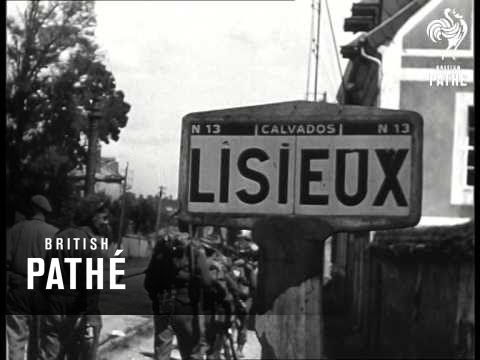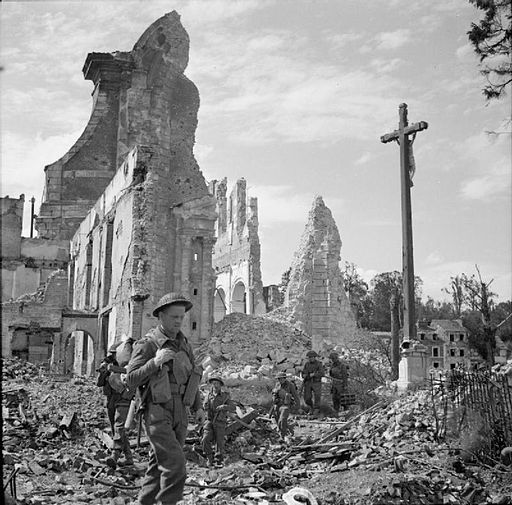Saint Therese of the Child Jesus
of the Holy Face
Film footage and many photos of Lisieux before and after the bombing in the summer of 1944
To mark the 70th anniversary of the Allied invasion of Normandy, please see films and photos of Lisieux in the summer of 1944.
Film of the liberation of Lisieux on August 23, 1944. Note the sign "Saint-Desir," the quarter in which the Benedictine Abbey where Therese studied had been located. The Abbey and the church where Therese made her First Communion were destroyed that night. You will also see a sign pointing the wya to the Carmel. Above the hill on the outside of the town you'll see the Basilica still standing.
Below are many images and films to see on their home sites if you make the effort to click the links:
Click for a still photo of St. Jacques Church, substantially destroyed. It has since been rebuilt but is no longer a church but a municipal exhibit hall.
At this link http://www.jpaventure.com/ click on “Lisieux 1944” for many photos of Lisieux before and after the bombing, including some of the Benedictine Abbey, St. Desir Church where St. Therese received her First Communion, Les Buissonnets, St. Jacques Church, St. Pierre Cathedral, and other sites.
At http://www.leveildelisieux.fr/2013/08/23/lisieux-meconnaissable/ see the photo of three nuns standing in front of Les Buissonnets showing a bomb that fell in the garden but never exploded.
A paragraph describing the battle of Lisieux on August 23, 1944, which led to its liberation. With thanks to www.normandie44lamemoire.com
At http://www.criticalpast.com/products/location_history/Lisieux_France/1940/1944 are two short films with footage of Lisieux in 1944:
- The first, filmed on August 23, 1944, is: "British soldiers fight the Nazis in Lisieux and General Charles De Gaulle visits Chartres en route to Paris liberation," one minute long.
- The second, "The bomb damaged town of Lisieux, France during World War II," also one minute long, shows the rescue operation.
St. Therese's sisters live through the bombing of Lisieux in the summer of 1944
You can read about the experience of St. Therese's two surviving sisters during the bombing of Normandy in 1944 at the Web site of the Archives of the Carmel of Lisieux,
Click on the English translation of the obituary circular of St. Therese's sister Pauline, Mother Agnes of Jesus, prioress of the Carmel, and scroll down to Section VII, "Her Last Days." The circular notes that on May 3,1944, Pope Pius XII signed the decree declaring St. Therese of the Child Jesus secondary patroness of France, the equal of her "dear sister," Joan of Arc. Due to the war, Mother Agnes did not receive this document until June 12, 1944, by which time she and the other Carmelites had taken refuge with other townspeople in the crypt of the basilica of the new Patroness of France. Let's pray that St. Therese, whose protection extended to so many during both World Wars, will obtain from God a renewal of the faith in France and in the whole world.
Click on the English translation of the obituary circular of St. Therese's sister Celine, Sister Genevieve of the Holy Face, and scroll down to Chapter V, "Sunshine and Shadows Over Carmel," to read of Sister Genevieve's experience that summer and of what a great sacrifice it was to her, in the crypt, to put up with the requests of the townspeople to speak to the sisters of St. Therese. See a photo of the crypt of the basilica taken in 1944.
We thank the Archives of the Carmel of Lisieux and their collaborators for making the story of the lives of the sisters of St. Therese available on the Web.
"Lisieux and the Allied Normandy Beach Landing 1944," courtesy of "Therese de Lisieux No. 845 - June 2004"
The Allied troops enter Lisieux in the summer of 1944. At the top, the Basilica of St. Therese
With thanks to the late Fr. J. Linus Ryan of Ireland, I am happy to present this excellent brief account of the bombing of Lisieux, a precise narrative of what happened to the town and to the Carmelite nuns in the summer of 1944, mentioning the public promise made on July 20, 1944 by curates of the town's three churches to celebrate the feast of St. Therese every year by bringing her relics in procession from St. Pierre's Cathedral to the Basilica. The article was translated by Teresa Geslin Sweeney from "Therese de Lisieux," the magazine published by the Shrine at Lisieux; it appeared in English on the Web site of the Irish National Office of St. Therese.
"How Lisieux Was Bombed: Little Flower's Sanctuaries, House, and Her Surviving Sisters Safe," by Maurice Desjardins. The Catholic Herald, October 6, 1944

A journalist reports on how the bombing of Lisieux affected the Carmelites and tells the circumstances of the deaths of many other nuns: he learned the story from the Pilgrimage Director, Mgr Germain, three weeks after Lisieux was liberated. Read the story of "How Lisieux Was Bombed."
"The Miracle of Lisieux: An eyewitness account by a Carmelite of Lisieux of the bombing of Lisieux on June 6, 1944 and of the nuns taking refuge in the crypt of the Basilica until the liberation
 British troops wend their way through the ruins of Lisieux, 22 August 1944. They stand before the destroyed parish church of St. Desir, which was also the chapel of the Benedictine Abbey where St. Therese made her First Communion on May 8, 1884. The Abbey received a direct hit the day after D-Day; the great crucifix at right was unharmed.
British troops wend their way through the ruins of Lisieux, 22 August 1944. They stand before the destroyed parish church of St. Desir, which was also the chapel of the Benedictine Abbey where St. Therese made her First Communion on May 8, 1884. The Abbey received a direct hit the day after D-Day; the great crucifix at right was unharmed.
"Fire broke out in several places, and there was neither water to put it out nor firemen to fight it. We were surrounded by it and on the night of June 7 we were forced to evacuate and to find refuge in the crypt of the Basilica, where we remained until August 27."
These lines are from a letter dated September 8, 1944, written by Sister Anne of Jesus, a Carmelite nun of Lisieux, and addressed to the Carmelite community at Three Rivers, Quebec. The letter is quoted extensively in the story "Carmelites Reveal 'Miracle of Lisieux'": Petition to Mary and St. Therese Brings Protection of God," published by the Arkansas Catholic, November 3, 1944. Please click on the title to read this eyewitness account of the fate of the Carmelite nuns of Lisieux. During the terrible bombing of June 6-7, 63 nuns from various religious communities in Lisieux died. All the Carmelite nuns survived. We are most grateful to the archives of the Arkansas Catholic for the chance to share this historic account with you. Please do click to see a legible scan of the actual 1944 newspaper with this amazing story. This entry is in honor of the 70th annniverary of D-Day.
Thanks to the Southern Cross newspaper, I have been able to verify that the photograph above shows British troops standing amid the ruins of the parish church of St. Desir, which was next to the Benedictine Abbey of Notre Dame du Pre, where St. Therese made her First Communion on May 8, 1884, sixty years before.